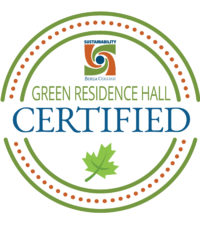

About
Because life’s a little different right now, we understand that Green Certification efforts are more difficult. This is a space for people to explore practical ways of incorporating sustainability on an individual basis. We encourage people to continue making small actions to green up their lives. We believe that small actions really do make a difference.
Take Action

Did you know that 1/3 of food produced each year is wasted?
This amounts to 1.3 billion tons worldwide!!!
How to reduce your food waste:
- To cut down on purchasing extra food that may need to be thrown away later:
- Plan your meals and shop accordingly
- Purchase fruits and veggies more often in less quantity.
- Keep your pantry organized so you know what you have before shopping
- If you have fruit and veggies that are about to go bad, toss them in the freezer! Then make them into soups, smoothies, or baked goods. Learn about other ways of using food waste.
- Save your food scraps (fruit and veggie peels, bread crusts, cracker crumbs) and toss them into your countertop composter, garden, yard, or start a compost pile. You can even use this compost as fertilizer for your house plants!
- To take composting to the next level, explore the idea of vermiculture.

Over 400 billion cups of coffee are consumed each year. In the U.S. alone, 450 million cups of coffee are consumed each day.
How to caffeinate sustainably:
- Make your own coffee at home:
- Purchase fair trade (check out Peace Craft or one of these awesome brands)
- Go for one of the following options:
- Love coffee pod’s convenience? Check out Tayst and Purpod for compostable coffee pod options
- Reusable coffee filter
- Unbleached coffee filters (can be composted safely)
- If you do go out for coffee:
- Ask for your coffee without a lid
- Bring your own coffee cup to cafes
- Support local cafes

It probably isn’t surprising to you that the average household receives 848 pieces of junk mail a year. This amounts to 41 pounds.
Roughly 80 million trees are consumed a year to produce paper that will be tossed shortly after receiving it..
Use these four sites to stop (most of) your junk mail:
- Direct Marketers Association (to take your name off most mailing lists)
- Catalog Choice (Free service allows you to take your name off specific mailing lists)
- Opt Out (to avoid receiving unwanted credit card or insurance offers)
- Yellow Pages (to stop receiving phone books)

In 2018, 87 billion packages were shipped in the U.S. This number has increased even more in todays world.
Online shopping can reduce carbon emissions, but only if we’re mindful.
How to ship from Amazon sustainably:
- Amazon Prime members:
- If you’re buying quite a few items at once, consolidate packages to ship together. This limits the carbon emissions used to ship your packages to a small percentage.
- Utilize (free) Amazon Day delivery: choose one day a week to have ALL your products shipped to you
- For everyone:
- If you aren’t in a rush, choose the slowest shipping method possible. Usually the slowest method is the cheapest and has the least carbon footprint per package.
- Buy in bulk. This reduces your package’s carbon footprint and reduces packaging waste.
- Choose products that have the designation “Compact by Design” over others. This means the product was designed efficiently, to do the same work with fewer materials.

Simply put, these are the stated goals of the Paris Climate Agreement:
The central aim is to strengthen the global response to the threat of climate change by keeping a global temperature rise this century well below 2 degrees Celsius above pre-industrial levels and to pursue efforts to limit the temperature increase even further to 1.5 degrees Celsius.
Organizations across the country chose to Stay In and fight the climate crisis, including us, Berea College.
How can you STILL BE IN and save money? Reduce your energy consumption.
The energy needed to power the built environment (residential and commercial) accounts for the highest percentage of global greenhouse gas emissions.
As a renter or homeowner in Kentucky, beyond just the basics to conserve energy, you have options to receive energy efficiency audits to pinpoint the best approach to reduce energy consumption saving you money and reducing greenhouse gas emissions.
We are fortunate to have experts right in our own back yard through Berea-based Mountain Association (MACED). Reach out to Chris Woolery with the Mountain Association who can tell you about your options… chris@mtassociation.org or (859) 621-4765.

Creativity:
- make art, journal, or color as research says these can help relieve stress. Find some free coloring pages
- make a chill music playlist (learn how on YouTube or Spotify) and listen to it when you’re feeling on edge
- shed some light on your work and sit by a window to improve productivity
- use Aromatherapy, find your preferred calming scent
- Interrupt negative thoughts. Catch yourself saying unkind things or thinking too much into things you can’t control and get yourself motivated. Remember: “worrying means you suffer twice” -Newt Scamandar (Harry Potter Universe)
Connect:
- limit your screen time as much as you can, or to 2 hours a day when possible
- laugh, chat with a funny friend or watch a funny movie or comedian
- snuggle with a pet
- with nature: keep plants and go for a hike
Move:
- feeling wound up? Do some yoga or go for a walk mindfully
- go swimming or put your face in a bowl of cold water, learn about water’s benefits for reducing stress and other ways to keep calm.
Did you know that Berea’s Thrive Dimensions of Wellness covers Sustainable wellness? Learn more about how sustainability affects “social justice, environmental integrity, and economic well-being today and for future generations.”

What is Greenwashing?
- Greenwashing is disinformation about the green values of a business disseminated as a marketing strategy so as to present an environmentally responsible public image regarding the company and its products. Businesses use buzzwords, such as “sustainable” or “eco-friendly”, in advertisements and marketing messages. But they offer no practical meaning to consumers. The term “greenwashing” comes from the term “whitewashing”, which means hiding the unpleasant facts or truth about it in order to make it acceptable (Collins dictionary).
Why is it an issue?
- Symbolically the brand is only pretending to be sustainable. This creates misdirection and distracts well meaning people from actual sustainable outcomes
- Greenwashing takes away the focus on actual sustainable practices, such as sustainable design or creating a circular economy
How can I spot it? Check out the Seven Sins of Greenwashing:
- Hidden Trade-Off: Labeling a product as environmentally friendly based on a small set of attributes (i.e., made of recycled content) when other attributes not addressed (i.e., energy use of manufacturing, gas emissions, etc.) might make a bigger impact on the eco-friendliness of a product as a whole.
- No Proof: Making an environmental claim without providing easily accessible evidence on either the label or the product website (i.e., a light bulb is touted as energy efficient with no supporting data).
- Vagueness: Using terms that are too broad or poorly defined to be properly understood (i.e., an “all-natural” cleaner may still contain harmful ingredients that are naturally occurring).
- Irrelevance: Stating something that is technically true but not a distinguishing factor when looking for eco-friendly products (i.e., advertised as “CFC-Free”—but since CFCs are banned by law this is unremarkable).
- Lesser of Two Evils: Claiming to be greener than other products in its category when the category as a whole may be environmentally unfriendly (i.e., an organic cigarette may be greener, but, you know, it’s still a cigarette).
- Fibbing: Advertising something that just isn’t true (i.e., claims to be Energy Star Certified, but isn’t).
- Worshiping False Labels: Implying that a product has a third-party endorsement or certification that doesn’t actually exist, often through the use of fake certification label
- Check out a specific brand’s connection to environmental and human health

We all know that Berea makes a no-tuition promise to every enrolled student. But, how is that possible? And how we fund Berea’s Tuition free guarantee, does it align with our values?
Rachel Hidding, the Office of Sustainability’s Green Office Certification Coordinator, dove into the topic and interviewed Dr. Nancy Sowers, our finance professor and past chair of Berea’s Committee for Socially Responsible Investing (SRI).
Rachel : How is it possible that Berea can offer it’s no-tuition promise?
Dr. Sowers: Berea College has a $1.2 billion endowment managed by the school each year. The endowment is the aggregate of our assets, usually a very large sum of money, provided by donors, grants, and wise investment over a very long period of time. Our endowment is invested so it grows to a much larger sum, and all the money raised is used to provide for the mission of the college, the education of our students, the programs they take part in while here, and the maintenance of our campus and our community for tomorrow’s generations that will attend here.
Rachel: Wow, a billion dollars? That’s impressive. So, if we’re investing it, how do we know that a lot of supposedly profitable investment opportunities aren’t harming the workers or the environment? And, if Berea is a school focused on social justice, how can all our money be potentially supporting various practices that are, in fact, unjust?
Dr. Sowers: It’s true that a lot of companies in our world aren’t always the most ethical with their practices. This issue came up several years ago, before I even worked here, within the Berea community, and there was a Committee added for this purpose: the Committee for Socially Responsible Investing. This group is focused on investing in ways that are sustainable socially, environmentally, and in line with good corporate governance. The committee’s charge is to look at the College’s investment practices and evaluate them in light of our Great Commitments. In essence, the committee acts as a liaison between the trustees on the Investment Committee and our community to ensure that the endowment is invested with our community values in mind. The trustees of the college have to be sure that college investment produces a return that is sufficient to support our mission, but they recognize that part of that mission, as guided by our Great Commitments, is about social and economic justice. Sustainability is fundamental to this community.
One thing the Board of Trustees has done is invest 10% of $1 billion ($100 million) in an ESG fund. ESG stands for “Environmental, Social, and Corporate Governance.” Environmental looks at how the company’s actions affect the physical environment’s health. The social lens provides an idea of how they treat their workers. The governance of the company is evaluated by the likelihood that the people in charge are attentive to how their actions affect shareholders. By looking at the way that a company performs compared to its industry’s standard, we can get a simple snapshot of the company’s sustainability and societal impact on the world. The size of this investment by our Board of Trustees is significant and reflects our community values. The last I saw, that investment had grown to $113.87 million (July 2019).
Rachel: This is so interesting. I had no idea that we could find this information as consumers. And tell me, why, other than for moral reasons, should someone be extra interested in a company’s ESG score?
Dr. Sowers: Many people are now seeing ESG values as criteria that help determine companies’ future financial performance better. Because these companies are behaving in a way that positively affects the communities and environment around them, the companies typically perform better in the long term financially. They many times have the potential to be more profitable investment opportunities over time because they have a long term view of their own success and are acting on it with that long run, sustainable success in mind.
Rachel: So, you are saying, I can both be morally correct in my investments AND make money. That is incredible! So, if I were to want to invest my money in companies that align with my standards for proper business practices, how can I find out which ones to choose?
Dr. Sowers: There are several options for you and the free information out there increases every day. For example, go to Yahoo Finance and search for a particular company’s “Quote.” After doing so, you will see a list of tabs in blue, one of them will be labeled “Sustainability.” By clicking on this tab, you will find the company’s ESG score in comparison to the industry peer scores. If possible, make sure the company has a higher score than peers and that the percentile score is high. You can also check out a website, censible.co. Here, you can check out more specifics about the practices of a company, how they treat their workers, their carbon footprint, their approach towards consumer health, and quite a lot more. And though these websites are great to evaluate a company, make sure to also use your common sense. Just because an oil company might be best in its class of scores for all oil companies, that might not be something where you want to see your investment dollars. Having said this, only you can decide that aspect of your investment, but be sure to stay diversified across sectors.
Rachel: My view is that Berea College is an incredible place. Our focus on sustainability and social justice extends past what we typically think while supporting our mission. Embracing environmental and socially just practices in all aspects of life can be incredibly beneficial for the world and for the people in it.

It’s no secret we’re all spending a lot of time at home working nowadays. Though we may not be driving to the office, printing out reports, or using coffee cups every morning, we are still impacting the world around us. We also may be facing different stressors working from home than we do at the office, check out what these stressors are and how to manage them. Here is a little list of tricks to make your home office a little more pleasant, green, healthy, and productive
- Sit by a window and use natural light, if lamps are needed go for LED light bulbs, it will save you money and reduce your home’s energy use and carbon footprint. Sitting by a window will also improve productivity and your health
- Choose eco-friendly, locally produced, and/ or second-hand furniture. For eco-friendly furniture look for products made from bamboo or hemp or for products that are GREENGUARD certified or Cradle to Cradle certified.
- Check out what’s in your paint- make sure it’s free from toxic pigments or volatile organic compounds.
- Recycle if possible. If you don’t have recycling in your hometown, check out sites like Terracycle where they recycle very specific products or search for independent recycling programs close to you. Do your best to compost and reduce your single use plastic use and overall waste production.
- Purchase some plants! Berea College’s Farm Store has some great, locally grown plants for sale throughout the year.
- Go for Fair Trade coffee and tea. Check out our featured Tip and Trick above to learn about why Fair Trade is so important
- Try to avoid printing- keep stuff digital. Print something one-sided? Use the other side for handwritten notes.
- Take some breaks, drink some water, and go outside for a walk or get fresh air. This will make you more productive and is great for your health. Taking a 15 minute break after every 1 hour spent working can be incredibly benefical. Here are some ways to take a break, and why it’s important.

Berea College’s Office of Sustainability offers a service known as the Green Office Certification. This certification is to encourage and acknowledge offices on campus to strive for practices that are sustainable for the environment and for the people working there. Stella Welsh, Student Labor Relations Specialist at Berea, shared her experiences of going through the certification process with Rachel Hidding, Berea student.
Rachel: What was your favorite part of the Green Office Certification process?
Stella: I really enjoyed the community it helped create within the Hafer-Gibson building. We went through the process with all the offices in the building together. Everyone was new at Hafer-Gibson at the time and this helped us get to know our building mates. It was a really simple process because we were all settling in anyway, we could establish sustainable practices, acquiring recycling bins and putting up signage right from the start.
Rachel: That’s so cool that you could build in sustainable practices right from the start. What parts of the certification process were challenging?
Stella: Because everyone is so caught up in the busyness that is Berea, it was sometimes easy to put the process on the backburner. To mitigate this, we worked hard to make it a priority and chip away at it a little, day by day. Working just a small amount everyday added up to some big changes.
Rachel: That seems to be a common trend with people working through the process, everyone at Berea is VERY busy. As you were going through the survey, what surprised you the most? What was your biggest aha moment?
Stella: I think it was the sheer amount of paper used. And it seemed to be for no reason. Because of the pandemic, we have really changed this. Before, we had a very paper intensive process that we had used for a long time, like the Labor Overloads. But with the pandemic, everything is now digital. It has really helped us to streamline waste in the office.
Rachel: That’s so true! A lot of people have worked to make their offices paperless over the past year or so. From what you can tell, with people working at home, are people staying green at their home offices?
Stella: I hope that many people are still being green at home. And even if they aren’t, I think the conversation is there and people remember the expectation that they be sustainable at work. And this is good to have in mind that there are some options for healthy habits.
Rachel: That’s so awesome, we hope that people who have previously received Green Office Certifications are keeping up those, as you call them, “healthy habits” at home. I’m curious, what made you interested in being more sustainable, both at work and in life?
Stella: I too was a Berea College student and I cared about sustainability even before attending school. I grew up with a family who was pretty outdoorsy. We didn’t watch TV and instead would hike, camp, and play outdoors. My family never used the fancy buzzwords about sustainability, but the love of the environment was definitely there. When I got to Berea’s campus, I learned a lot. I realized people could make whole careers out of sustainability. I took a few SENS classes and after graduation, I lived in some pretty remote places. When you live in the middle of nowhere, sometimes it’s just easier, and more economic, to grow your own food or to drastically reduce your trash output if you live somewhere without a trash pickup. Eventually, with my son being born, I had to be creative with ways to reduce our carbon footprint. There are some sustainable ways of bringing children into the world and I hope to be an example to my son and to others of how to be sustainable.
Rachel: It sounds like you’ve lived a really cool life and have some awesome motivation to be environmentally friendly! Can you tell me how you kept other people motivated in the Green Office Certification process?
Stella: Everyone at the Labor Office was pretty competitive and we wanted the highest score of certification we could. Motivating people in the building of Hafer-Gibson overall, was just a happy thing. Everyone was learning how to operate in their new space and we were going through a lot of changes anyway.
Rachel: Thanks so much for sharing your experience with me. Going through the certification process with offices is really eye opening and enjoyable. If anyone else is interested in completing the certification, fill out a form here to notify us of your interest and we’ll get you started!

Berea College offers a program called the Green Office Certification. This certification houses various categories: water, energy, waste, purchasing, paper consumption, meetings, and transportation. These categories are all very important to helping reduce an office’s footprint. One of the categories, waste, presents the most obvious and easiest ways to be a bit more sustainable in our everyday lives. 13% of the certification focuses on how offices can reduce their waste. This is important because, as we know, it’s not possible to truly throw something away. There is no away. We just hope it’s not in our own backyard. Boyd County becomes a good example of turning into someone else’s trashy backyard.
The students of Boyd County High School smelled rot everyday as they went in and out of school. Running on the track, they were overwhelmed by pungent fumes. Students were so sickened by the acrid aroma. Runners on the track team had to stop practicing as they couldn’t run while breathing this polluted air. The town was inundated with a horrible smell, permeating all around the area. The smell was flowing from the town’s landfill, full of trash that was not their own.
In 2014, Boyd County became the host of waste from the Northeastern United States, a proposed 7,000 tons. The trash was being shipped in by train and dumped next to the local high school. The train carried an overwhelming stench. The culminating scent emanating from thousands of tons of garbage could be detected from seven miles down the road. 3,500 tons of trash were dumped each day and the plan was amended to house 43,000 tons. Eventually, the smell got so bad that Kenny Messer wrote a song about it, the Trash Train Blues.
It seems ludicrous that a place would agree to house another communities trash. However, Boyd County was looking for new opportunities for employment and income. It had been a booming area for industry in the early 20th century but slowly, these industries holding up the economy began to move away. In 2014, the county had a budget of $20 million per year. With the landfill offering an additional $1 million and 50 additional jobs, it was a tempting prospect. But the meager job opportunities seemed light as time progressed and citizen’s health declined. Berea College’s Jason Miller, Senior Writer for Berea’s Marketing and Communications, is from Boyd County. Miller was asked how he would respond to someone mentioning the potential economic benefits the landfill offered in terms of jobs. Jason stated that though those jobs meant a lot to the 50 families being supported by them, the “cost was just too high.” The landfill was affecting 1000’s of people and reducing the integrity of the town. The area was assumed to be quite rural. But, if you examine a map of the tristate area, you can see that this landfill was in an area with close to 700,000 people.
Citizens were moved by the smell. The Boyd County Environmental Coalition took charge. One of their star players was Judy Conner Nichols, high school civics teacher, member of Boyd County Board of Education, and mother of Jason Miller. She had talked to Jason about the incredible stench and felt called to do something about it. They brainstormed and decided that fighting big corporations alone is close to impossible. They formed a team, Miller, who had just started at Berea, reached out to Joan Pauly, Berea College’s Sustainability Coordinator, and Nancy Gift, Chair of Sustainability Studies. These two environmentalists connected Miller and Conner Nichols with Tom Fitzgerald, an environmental lawyer. Fitzgerald was a key player in fighting the company, Enviro Solutions. The solid waste management company was based in New Jersey and was too big for someone to fight alone. They knew they needed the legal expertise and experience of someone fighting these big corporations.
While Fitzgerald led the fight against this big company, actors within the community had their own battle trying to get everyone in town on the same side. The 50 families with at least one member employed by the landfill were reluctant to oppose it. Many people allied with these families out of loyalty to their friends and neighbors. It took the persistence of Conner Nichols to convince some key players, such as the head of the school board, to switch sides. Eventually the landfill was capped and the smell is gone. We’re unsure where the trash brings its blues to now, but the hope is that it’s being handled in a responsible way.
Miller states, “it’s supremely wrong to export trash to small communities with few resources. It simply is not fair.” With this statement and through this story, Miller is referring to a concept known as environmental justice. Pollution and other environmental issues disproportionately affect minority communities and groups of a lower social class. Environmental justice focusses on fair practices and involvement of people in response to various environmental decisions to make their communities and our world a better place. Many times these communities don’t have the resources to stand up against these groups, or don’t have the option to do so out of desperation for employment. Many people face environmental injustices. If this ever becomes the case in your own community, Miller recommends connecting with others. This could be an environmental lawyer, fellow community members, or other activists. It’s also beneficial to “get political buy in at home” (Miller). Others may have expertise and connections that are integral to your campaign.
Landfills pose many health issues and can reduce the integrity of a landscape. Many people don’t think too much about where their waste goes after they plop it into the appropriate bin. If someone does think about it, they’ve probably forced themselves to accept the large-scale waste that is created from our consumption. People tend to not think about their contribution to this large-scale waste. Each American throws away, on average, 5 pounds of waste each day. Our campus, Berea College, is working to become a zero waste campus by 2036. Zero waste is defined as diverting 90% of our waste to either recycling or compost. To achieve this, it will take all of us educating ourselves and gently holding each other accountable. And it’s easy to point fingers at someone who is a big tosser. But, it’s not possible to address the issue of waste without also recognizing that industry plays a big role in our waste production as they create the products we purchase. It must be a coordinated dance of public and personal responsibility for us to achieve a world defined less by the ravages of waste and more by the creativity and intention that can come from living more sustainably.

Berea College’s Office of Sustainability, in the average year, hosts the Dandelion Festival each spring. This celebration is honoring pollinators, the native plants of Appalachia, and how Berea College’s campus landscape strives to be environmentally friendly. Berea College’s campus uses “No Spray” practices. Walking around campus, you may have noticed different flowers blooming in the grass, or weeds growing in the Quad. This is exactly what we want. By allowing a variety of plants to grow, we are respecting nature’s diversity. With more diversity, we are supporting a healthy insect population. This is especially important as the world’s insect population has shrunk 27% in the last 30 years.
The insects we are most interested in, for the purpose of the Dandelion Festival, are pollinators. Pollinators need sustenance in the spring and what they can rely on is these golden blooms. Dandelions are one of the first plants to bloom in the spring, without them, bees and other pollinators would have meager options for food. If you’re walking around Berea’s campus, take note of the areas that are especially good for pollinators. There are several Way Stations on our campus championed by our First Lady Roelofs, specifically for monarchs, earning Berea the distinction of being a Bee Campus.
Many people don’t think about it, but dandelions are edible for humans as well. The greens are great for salads and teas can be made from the roots. Appalachia’s history of foraging has led many people to love its resilience and abundance in the spring. The plant was used for a wide variety of things and is still highly respected today. Other forages found throughout our landscape are also useful for eating, medicine, or crafts. For anyone interested in consuming forages with minimal risk, check out Earthy Delights.
Here are some other ways to encourage an eco-friendly lawn to reduce need for watering, chemicals, and mowing:
1) avoid chemical applications
2) choose to plant native plants
3) plant ground cover instead of grass, the most popular alternative is white clover
4) mulch around your flowers, this holds in moisture, reducing the need for watering
5) compost your food waste
6) harvest rain water, rain barrels
7) change your mindset and the mind’s of your neighbors, to appreciate a diverse lawn
8) find ways of appreciating “weeds” such as making a flower crown or creating the following any of these awesome recipes.

There is a concept in the world of sustainability called “tragedy of the commons.” This concept refers to the trend of overconsumption of resources whenever there is not a clear owner of these resources. It typically occurs as people hoard resources to meet their own needs. An example of this can be seen in overfishing of our oceans, learn about it more here.
This overconsumption can be can be ameliorated by having gratitude. Studies show that people who give thanks live more sustainably. The more we are able to appreciate our place in life, material possessions, and social connections, the more likely we are to participate in sustainable consumption. It can be hard to consume responsibly if we cannot appreciate what we have.
There are many ways to give gratitude:
- Begin or end your day with a ritual of giving thanks- either by thinking about things you’re grateful for or writing them down
- Go out of your way to do something kind for a stranger
- Be mindful as you eat and drink, recognize the effort and resources it took to create these products
- Make people feel heard by actively listening
- Be intentional by slowing yourself down, prioritizing just a few tasks, and simplifying your media consumption
- Send someone you’re thankful for a kind note, a small token of appreciation, or show your appreciation through a kind favor